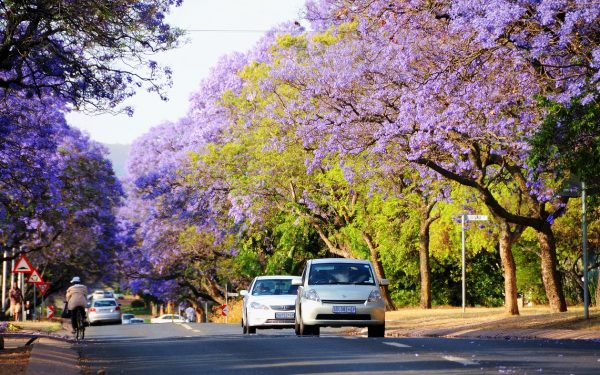

Follow us on:  
|


Many tourists flock to South Africa to take in its natural beauty, such as these flowers of the Jacaranda blossom in Pretoria [Xinhua]
The number of overseas tourists, in particular those from South Africa’s BRICS partners, remained below their 2013 levels.
The release of the report also highlighted Stats SA’s resource constraints as its budget has been cut by R400 million ($30.6 million) this fiscal year. The Tourism report this year was released in mid July, more than three months later than last year’s report.
New visa regulations from October 2014 that required an in-person visit for biometric data to South African consulates for visitors from non-visa exempt countries such as China, Russia and India had an impact, but there were other factors at play as only one (The Netherlands) of the top ten overseas source countries showed an increase in 2014 compared with 2013.
The visa requirements were relaxed and the capacity to process them was improved in 2015 and 2016 in a belated attempt to mitigate the effects on the tourism industry. As ten tourists are estimated to create one job, the near 100,000 drop in BRIC tourist numbers from 359,429 in 2013 to 259,444 in 2016 has cost some 10,000 jobs at a time when the unemployment rate exceeds 27 per cent.
The Department of Home Affairs administers the visa requirements. Several countries such as Brazil and most European countries are exempt from visas provided they stay less than 90 days.
Visas are not issued at South African ports of entry, and airline officials are obliged to insist on visas before allowing passengers to board. If a visitor arrives without a visa, immigration officials are obliged to put the visitor onto a flight back to the country of origin.
Chinese plunge
South African hotel groups such as Southern Sun said the removal of South Africa from Chinese tour operator brochures due to the biometric requirements probably explained the 62 per cent plunge in Chinese tourists between November 2013 and November 2014. The annual decline was 45.1 per cent for 2014 after a 14.2 per cent increase in 2013, but in 2016 there was a 38.1 per cent recovery.
India overtook China as the leading BRIC source country in 2014 even though India is also not a visa exempt country, as tourists from India travel far less in tour groups, but rather as families and friends.
But there was still a 23.6 per cent decline to 85,639 in 2014. In 2016 there was a 21.7 per cent rebound and Tourism South Africa is currently busy with a major campaign in India to ensure that Indian tourists to South Africa exceed 100,000 in 2017.
Tourism South Africa has tied up with the Travel Agents Association of India (TAAI), and under this arrangement, more than 1,500 front-line agents are being trained to promote South Africa in India.
Hanneli Slabber, who is in her seventh year as country chief for Tourism South Africa in New Delhi, said that Indian tourists traveled to South Africa in the lean months, which helped balance out the tourism accommodation industry.
She pointed out that job creation and tour packages were important aspects of travel, not just numbers.
A matter of distance
Although Russian tourist arrivals grew by 14.7 per cent in 2016, they remain 38.1 per cent below the 2013 level.
Mikhail Petrakov, who has been Russia’s ambassador to South Africa for five years already, said the main obstacle for growth in Russian tourists was the large distance between the two countries.
“I would dearly love to see more cultural exchanges and increased trade and tourism between South Africa and Russia, but the problem is that it expensive to bring the Kirov or Bolshoi ballet company out here for a tour of the country. We do have Russian companies investing in South Africa and South Africa runs a large trade surplus with Russia, so we have a base, but I would love to see our relationship deepen even further,” Petrakov told The BRICS Post.
International tourist arrivals worldwide grew by 6 per cent in the first four months of 2017 compared to the same period last year, with business confidence reaching its highest levels in a decade, according to the latest UNWTO World Tourism Barometer.
Sustained growth in most major destinations and a steady rebound in others drove results.
By Helmo Preuss in Grahamstown, South Africa for The BRICS Post